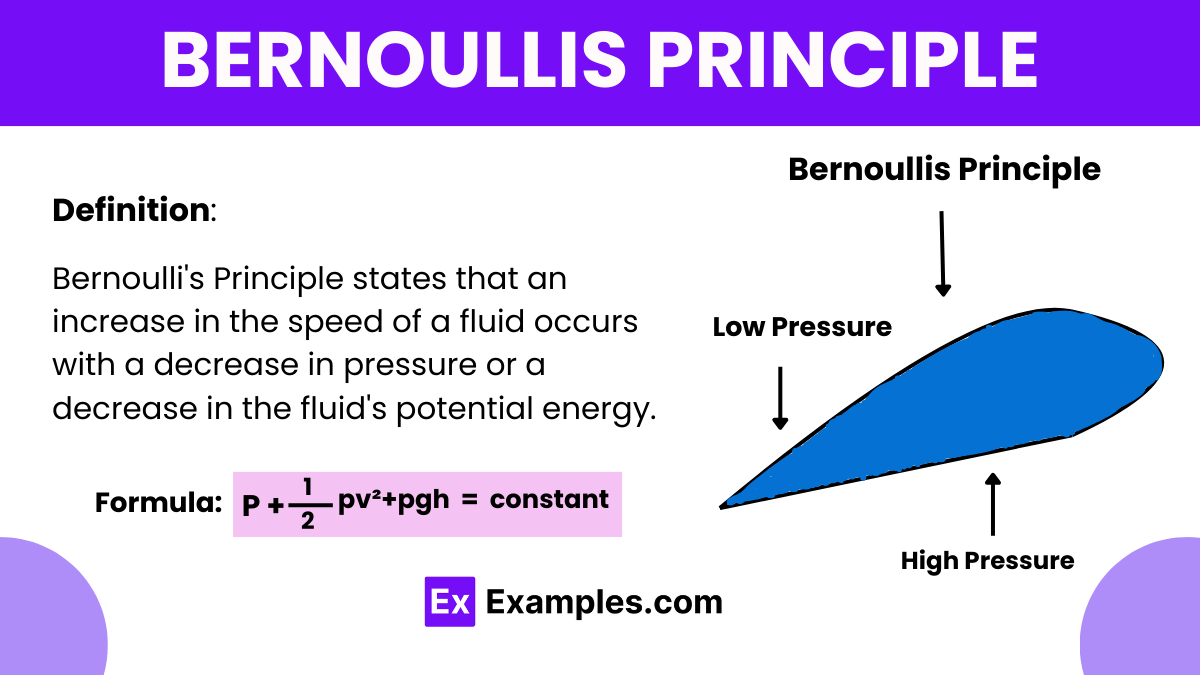According to Bernoulli's principle, what happens to the pressure in a fluid as its velocity increases?
Pressure decreases
Pressure increases
Pressure remains the same
Pressure fluctuates

Bernoulli’s Principle is a foundational concept in fluid dynamics, derived from the conservation laws of mechanics, specifically the conservation of energy. It states that in a flowing fluid, an increase in the fluid’s speed occurs simultaneously with a decrease in pressure or potential energy. This principle is crucial for understanding various phenomena in physics and engineering, such as the lift generated by airplane wings or the behavior of gases in pipelines. By applying the laws of motion and energy conservation, Bernoulli’s Principle helps explain how and why fluids behave as they do under different conditions. This relationship between speed, pressure, and potential energy is instrumental in many applications across both natural and technological systems.

The formula that represents Bernoulli’s Principle is expressed as follows:
Here’s what each term represents:
This equation essentially states that the sum of the static pressure, dynamic pressure (1/2𝜌𝑣²), and hydrostatic pressure (𝜌𝑔ℎ) is constant along any streamline in a steady, incompressible flow with negligible viscosity. This relationship allows for predictions of changes in fluid velocity, pressure, and elevation.
Bernoulli’s Principle is essentially an application of the conservation of mechanical energy to fluid flow. The total mechanical energy for a fluid element includes kinetic energy, potential energy due to gravity, and energy related to pressure.
Consider a small element of fluid moving along a streamline. The forces acting on this fluid element are due to pressure and gravity.
Assuming no heat transfer or energy losses (ideal conditions), the total mechanical energy remains constant along a streamline:
d(1/2ρv²)+d(ρgh)+PdV = 0
Here, 𝑑d represents the differential changes.
For incompressible flow, the Continuity Equation 𝜌𝐴𝑣=constantρAv=constant implies constant mass flow rate, helping relate velocity and cross-sectional area changes.
Converting the work-energy balance into a form using differentials and simplifying using the properties of incompressible flow:
dP/p+vdv+gdh = 0
Integrating this equation along a streamline from points 1 to 2, assuming steady flow and constant density 𝜌ρ, gives Bernoulli’s equation:
P₁+1/2ρv²₁+ρgh₁ = P₂+1/2ρv²₂+ρgh₂ = constant
This equation, Bernoulli’s equation, shows that the sum of pressure energy, kinetic energy, and potential energy per unit volume remains constant along a streamline in a steady, incompressible, non-viscous flow. It illustrates how changes in velocity and elevation affect the fluid pressure within a flow field.
A common misconception is that Bernoulli’s Principle is the sole explanation for lift in aircraft wings. While it plays a significant role, lift is also influenced by Newton’s Third Law as the wing deflects air downward. Another misconception is that the principle applies universally to all fluid motions, ignoring effects like viscosity and compressibility.
The Venturi effect describes the reduction in fluid pressure that results when a fluid flows through a constricted section of a pipe. According to Bernoulli’s Principle
Bernoulli’s Principle has practical implications in everyday life, including the design of exhaust and ventilation systems, the operation of garden sprayers, and the engineering of dams and water conduits.
Text prompt
Add Tone
10 Examples of Public speaking
20 Examples of Gas lighting
According to Bernoulli's principle, what happens to the pressure in a fluid as its velocity increases?
Pressure decreases
Pressure increases
Pressure remains the same
Pressure fluctuates
Which of the following best describes Bernoulli's principle?
An increase in fluid speed results in increased pressure
An increase in fluid speed results in decreased pressure
Pressure in a fluid is independent of its speed
Pressure in a fluid is directly proportional to its speed
What is the primary application of Bernoulli's principle in aviation?
Wing lift
Engine thrust
Fuel efficiency
Aircraft weight
How does Bernoulli's principle apply to a Venturi meter?
It increases fluid pressure
It measures fluid velocity
It decreases fluid speed
It measures fluid temperature
What is the effect of narrowing a pipe on the fluid speed and pressure according to Bernoulli's principle?
Speed decreases, pressure increases
Speed increases, pressure decreases
Speed and pressure both decrease
Speed and pressure both increase
If a fluid flows through a horizontal pipe and its speed doubles, what happens to its pressure?
It doubles
It halves
It decreases
It remains the same
How does Bernoulli's principle explain the functioning of a carburetor in an engine?
It regulates fuel temperature
It increases air pressure
It mixes air and fuel
It decreases air velocity
When fluid flows from a wide section of a pipe to a narrow section, what happens to the kinetic energy of the fluid?
It decreases
It increases
It remains constant
It fluctuates
What happens to the potential energy of a fluid as it descends a height according to Bernoulli's principle?
It decreases
It increases
It remains constant
It fluctuates
How does Bernoulli's principle apply to the operation of a perfume atomizer?
It increases liquid temperature
It creates a high-pressure area
It uses low pressure to draw liquid up
It decreases liquid viscosity
Before you leave, take our quick quiz to enhance your learning!

